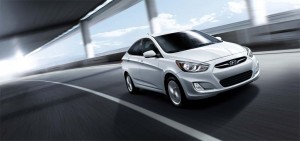
The Hyundai Accent is one of the more dangerous cars on the road today, if involved in a collision, a new study shows.
Drivers of small cars have long known that they are at greater risk when involved in collisions with larger vehicles. However, the risk is increasing, according to a new study.
The Insurance Institute for Highway Safety report suggests that traffic fatality rates are on the rise overall, but noted that of the top 10 vehicles involved in fatal crashes, five are minicars and three are small cars. The vehicle at the top of the list if the Hyundai Accent.
Despite the increase in the overall rate, the worst vehicles actually saw some improvement. The 2014 Hyundai Accent’s death rate of 104 compares with 120 for the 2011 Accent. The worst vehicle among the 2011 models was the Kia Rio with a rate of 149. The 2014 Rio’s death rate is 102.
Both models were redesigned in 2012, and their lower death rates may reflect the better crash-test performance of the newer designs, IIHS noted.
(Excess diesel emissions killing 38K annually, says new study. To get details, Click Here.)
The rest of the top five included the Scion tC 2-door car, which had 101 deaths; the Chevrolet Spark 4-door car; and the Nissan Versa.
At the other end of the spectrum, top five models with the lowest driver death rates – which was zero deaths – were the Volkswagen Tiguan 2WD SUV, Toyota Tacoma Double Cab long bed 4WD pickup, Mazda CX-9 2WD SUV, Audi A6 4WD and Audi Q7 4WD.
The overall rate of driver deaths for 2014 models was 30 per million registered vehicle years, which the group said was up from 28 for 2011 models, according to the study. While cars, trucks and utility vehicles continue to become safer vehicles, those advances are being offset.
“Vehicles continue to improve, performing better and better in crash tests,” said David Zuby, IIHS executive vice president and chief research officer, in a statement. “The latest driver death rates show there is a limit to how much these changes can accomplish without other kinds of efforts.”
(Click Here to see how an improved infrastructure could save 63K lives.)
The factor that innovation cannot overcome is the economy, in this case, the improving economy. Studies shows that as unemployment rates drop, traffic fatalities tend to rise because people are more mobile then whether is because they are travelling to work or for pleasure.
Recent statistics show that American’s are driving more miles than ever. Each of the last three years, U.S. drives have set a new record for miles travelled behind the wheel.
“Researchers found that the drop was driven largely by improved vehicle designs and safety technology,” the group said. “Such improvements have continued, but the new results show that, by themselves, they won’t be enough to eliminate traffic deaths.”
The IIHS study found that July and August are typically the deadliest months on U.S. roadways, with an average daily toll of 116, which the group attributed to driving patterns that increase in warmer summer months.
(Death toll rises as U.S. drivers keep engaging in distracted driving. Click Here for the story.)
Road deaths have been trending downward since the early 1970s, with an especially large dip beginning in 2008. However, that changed in 2015, with deaths increasing 7% over the previous year. Preliminary data indicate the toll increased in 2016 as well.
